[English] 日本語
 Yorodumi
Yorodumi- PDB-6zgc: Crystal structure of the ACVR1 (ALK2) kinase in complex with the ... -
+ Open data
Open data
- Basic information
Basic information
| Entry | Database: PDB / ID: 6zgc | ||||||
|---|---|---|---|---|---|---|---|
| Title | Crystal structure of the ACVR1 (ALK2) kinase in complex with the compound Saracatinib (AZD0530) | ||||||
 Components Components | Activin receptor type I | ||||||
 Keywords Keywords | SIGNALING PROTEIN / Inhibitor complex. Kinase. Type I receptor / BMP / Signalling. | ||||||
| Function / homology |  Function and homology information Function and homology informationendocardial cushion cell fate commitment / mitral valve morphogenesis / BMP receptor complex / cardiac muscle cell fate commitment / BMP receptor activity / endocardial cushion fusion / atrial septum primum morphogenesis / positive regulation of cardiac epithelial to mesenchymal transition / acute inflammatory response / positive regulation of determination of dorsal identity ...endocardial cushion cell fate commitment / mitral valve morphogenesis / BMP receptor complex / cardiac muscle cell fate commitment / BMP receptor activity / endocardial cushion fusion / atrial septum primum morphogenesis / positive regulation of cardiac epithelial to mesenchymal transition / acute inflammatory response / positive regulation of determination of dorsal identity / transforming growth factor beta receptor activity, type I / smooth muscle cell differentiation / activin receptor complex / activin receptor activity, type I / endocardial cushion formation / pharyngeal system development / transmembrane receptor protein serine/threonine kinase activity / receptor protein serine/threonine kinase / activin binding / cellular response to BMP stimulus / activin receptor signaling pathway / negative regulation of activin receptor signaling pathway / embryonic heart tube morphogenesis / gastrulation with mouth forming second / dorsal/ventral pattern formation / transforming growth factor beta binding / determination of left/right symmetry / atrioventricular valve morphogenesis / neural crest cell migration / branching involved in blood vessel morphogenesis / negative regulation of G1/S transition of mitotic cell cycle / ventricular septum morphogenesis / SMAD binding / germ cell development / peptide hormone binding / mesoderm formation / positive regulation of intracellular signal transduction / positive regulation of SMAD protein signal transduction / regulation of ossification / positive regulation of bone mineralization / positive regulation of osteoblast differentiation / BMP signaling pathway / negative regulation of signal transduction / transforming growth factor beta receptor signaling pathway / protein tyrosine kinase binding / negative regulation of extrinsic apoptotic signaling pathway / cellular response to growth factor stimulus / apical part of cell / osteoblast differentiation / heart development / in utero embryonic development / cell differentiation / protein kinase activity / positive regulation of cell migration / cadherin binding / protein serine/threonine kinase activity / positive regulation of DNA-templated transcription / protein homodimerization activity / positive regulation of transcription by RNA polymerase II / ATP binding / metal ion binding / plasma membrane Similarity search - Function | ||||||
| Biological species |  Homo sapiens (human) Homo sapiens (human) | ||||||
| Method |  X-RAY DIFFRACTION / X-RAY DIFFRACTION /  SYNCHROTRON / SYNCHROTRON /  MOLECULAR REPLACEMENT / Resolution: 2.67 Å MOLECULAR REPLACEMENT / Resolution: 2.67 Å | ||||||
 Authors Authors | Williams, E.P. / Galan Bartual, S. / Burgess-Brown, N. / von Delft, F. / Arrowsmith, C.H. / Edwards, A.M. / Bountra, C. / Bullock, A.N. | ||||||
 Citation Citation |  Journal: JCI Insight / Year: 2021 Journal: JCI Insight / Year: 2021Title: Saracatinib is an efficacious clinical candidate for fibrodysplasia ossificans progressiva. Authors: Williams, E. / Bagarova, J. / Kerr, G. / Xia, D.D. / Place, E.S. / Dey, D. / Shen, Y. / Bocobo, G.A. / Mohedas, A.H. / Huang, X. / Sanderson, P.E. / Lee, A. / Zheng, W. / Economides, A.N. / ...Authors: Williams, E. / Bagarova, J. / Kerr, G. / Xia, D.D. / Place, E.S. / Dey, D. / Shen, Y. / Bocobo, G.A. / Mohedas, A.H. / Huang, X. / Sanderson, P.E. / Lee, A. / Zheng, W. / Economides, A.N. / Smith, J.C. / Yu, P.B. / Bullock, A.N. | ||||||
| History |
|
- Structure visualization
Structure visualization
| Structure viewer | Molecule:  Molmil Molmil Jmol/JSmol Jmol/JSmol |
|---|
- Downloads & links
Downloads & links
- Download
Download
| PDBx/mmCIF format |  6zgc.cif.gz 6zgc.cif.gz | 295.4 KB | Display |  PDBx/mmCIF format PDBx/mmCIF format |
|---|---|---|---|---|
| PDB format |  pdb6zgc.ent.gz pdb6zgc.ent.gz | 192.9 KB | Display |  PDB format PDB format |
| PDBx/mmJSON format |  6zgc.json.gz 6zgc.json.gz | Tree view |  PDBx/mmJSON format PDBx/mmJSON format | |
| Others |  Other downloads Other downloads |
-Validation report
| Summary document |  6zgc_validation.pdf.gz 6zgc_validation.pdf.gz | 1.4 MB | Display |  wwPDB validaton report wwPDB validaton report |
|---|---|---|---|---|
| Full document |  6zgc_full_validation.pdf.gz 6zgc_full_validation.pdf.gz | 1.5 MB | Display | |
| Data in XML |  6zgc_validation.xml.gz 6zgc_validation.xml.gz | 43.4 KB | Display | |
| Data in CIF |  6zgc_validation.cif.gz 6zgc_validation.cif.gz | 56.5 KB | Display | |
| Arichive directory |  https://data.pdbj.org/pub/pdb/validation_reports/zg/6zgc https://data.pdbj.org/pub/pdb/validation_reports/zg/6zgc ftp://data.pdbj.org/pub/pdb/validation_reports/zg/6zgc ftp://data.pdbj.org/pub/pdb/validation_reports/zg/6zgc | HTTPS FTP |
-Related structure data
| Related structure data |  3h9rS S: Starting model for refinement |
|---|---|
| Similar structure data |
- Links
Links
- Assembly
Assembly
| Deposited unit | 
| ||||||||||
|---|---|---|---|---|---|---|---|---|---|---|---|
| 1 | 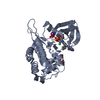
| ||||||||||
| 2 | 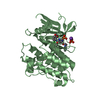
| ||||||||||
| 3 | 
| ||||||||||
| 4 | 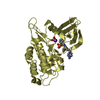
| ||||||||||
| Unit cell |
|
- Components
Components
| #1: Protein | Mass: 34537.633 Da / Num. of mol.: 4 / Mutation: Q207D Source method: isolated from a genetically manipulated source Details: Bound with the inhibitor Saracatinib (AZD0530) in the active site. Source: (gene. exp.)  Homo sapiens (human) / Gene: ACVR1 / Cell line (production host): Sf9 / Production host: Homo sapiens (human) / Gene: ACVR1 / Cell line (production host): Sf9 / Production host:  References: UniProt: Q04771, receptor protein serine/threonine kinase #2: Chemical | ChemComp-H8H / #3: Chemical | ChemComp-K / #4: Chemical | ChemComp-PO4 / #5: Water | ChemComp-HOH / | Has ligand of interest | Y | Has protein modification | Y | |
|---|
-Experimental details
-Experiment
| Experiment | Method:  X-RAY DIFFRACTION / Number of used crystals: 1 X-RAY DIFFRACTION / Number of used crystals: 1 |
|---|
- Sample preparation
Sample preparation
| Crystal | Density Matthews: 2.79 Å3/Da / Density % sol: 55.96 % |
|---|---|
| Crystal grow | Temperature: 277 K / Method: vapor diffusion, sitting drop / pH: 7.4 Details: 1.26M sodium phosphate monobasic 0.14M potassium phosphate dibasic |
-Data collection
| Diffraction | Mean temperature: 100 K / Serial crystal experiment: N |
|---|---|
| Diffraction source | Source:  SYNCHROTRON / Site: SYNCHROTRON / Site:  Diamond Diamond  / Beamline: I04-1 / Wavelength: 0.91741 Å / Beamline: I04-1 / Wavelength: 0.91741 Å |
| Detector | Type: DECTRIS PILATUS 2M / Detector: PIXEL / Date: Jan 26, 2015 |
| Radiation | Monochromator: single bounce / Protocol: SINGLE WAVELENGTH / Monochromatic (M) / Laue (L): M / Scattering type: x-ray |
| Radiation wavelength | Wavelength: 0.91741 Å / Relative weight: 1 |
| Reflection | Resolution: 2.66→44.84 Å / Num. obs: 41875 / % possible obs: 96.5 % / Redundancy: 3.3 % / Biso Wilson estimate: 57.36 Å2 / CC1/2: 0.993 / Rmerge(I) obs: 0.079 / Rpim(I) all: 0.051 / Rrim(I) all: 0.094 / Net I/σ(I): 7.8 |
| Reflection shell | Resolution: 2.66→2.77 Å / Redundancy: 3.4 % / Rmerge(I) obs: 0.499 / Mean I/σ(I) obs: 2.2 / Num. unique obs: 4448 / CC1/2: 0.79 / Rpim(I) all: 0.323 / Rrim(I) all: 0.597 / % possible all: 98.3 |
- Processing
Processing
| Software |
| ||||||||||||||||||||||||||||||||||||||||||||||||||||||||||||||||||||||||||||||||||||||||||||||||||||||||||||||||
|---|---|---|---|---|---|---|---|---|---|---|---|---|---|---|---|---|---|---|---|---|---|---|---|---|---|---|---|---|---|---|---|---|---|---|---|---|---|---|---|---|---|---|---|---|---|---|---|---|---|---|---|---|---|---|---|---|---|---|---|---|---|---|---|---|---|---|---|---|---|---|---|---|---|---|---|---|---|---|---|---|---|---|---|---|---|---|---|---|---|---|---|---|---|---|---|---|---|---|---|---|---|---|---|---|---|---|---|---|---|---|---|---|---|
| Refinement | Method to determine structure:  MOLECULAR REPLACEMENT MOLECULAR REPLACEMENTStarting model: 3H9R Resolution: 2.67→44.23 Å / SU ML: 0.3806 / Cross valid method: FREE R-VALUE / σ(F): 1.34 / Phase error: 29.3534 Stereochemistry target values: GeoStd + Monomer Library + CDL v1.2
| ||||||||||||||||||||||||||||||||||||||||||||||||||||||||||||||||||||||||||||||||||||||||||||||||||||||||||||||||
| Solvent computation | Shrinkage radii: 0.9 Å / VDW probe radii: 1.11 Å / Solvent model: FLAT BULK SOLVENT MODEL | ||||||||||||||||||||||||||||||||||||||||||||||||||||||||||||||||||||||||||||||||||||||||||||||||||||||||||||||||
| Displacement parameters | Biso mean: 60.89 Å2 | ||||||||||||||||||||||||||||||||||||||||||||||||||||||||||||||||||||||||||||||||||||||||||||||||||||||||||||||||
| Refinement step | Cycle: LAST / Resolution: 2.67→44.23 Å
| ||||||||||||||||||||||||||||||||||||||||||||||||||||||||||||||||||||||||||||||||||||||||||||||||||||||||||||||||
| Refine LS restraints |
| ||||||||||||||||||||||||||||||||||||||||||||||||||||||||||||||||||||||||||||||||||||||||||||||||||||||||||||||||
| LS refinement shell |
|
 Movie
Movie Controller
Controller


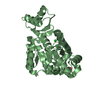
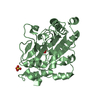

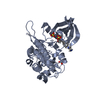

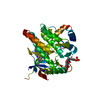
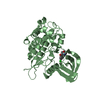
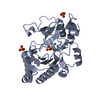
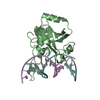
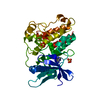
 PDBj
PDBj







